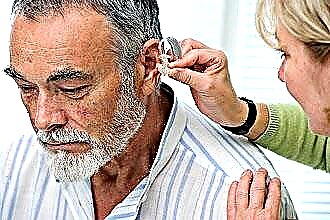Deafness is a pathological condition characterized by partial or complete hearing loss. The loss of the ability to detect and perceive sound vibrations of certain frequencies is called auditory dysfunction. Malfunctions in the auditory analyzer are often caused by post-infectious complications, traumatic brain injuries, the development of tumors and insufficient blood supply to the tissues of the hearing organ.
Why can't the ear hear? Dysfunction of the auditory analyzer is associated with disturbances in the operation of the sound-receiving or sound-conducting system. With the progression of ear pathology, patients lose the ability to distinguish between whispering speech and sounds with a vibration frequency below 26 dB. Untimely treatment of hearing loss, i.e. hearing loss, can cause the development of complete deafness.
Physiology

If the ear does not hear, the causes of dysfunction may lie in a pathological change in the state of the sound-conducting and sound-perceiving parts of the auditory analyzer. The well-coordinated work of the components of the hearing organ ensures the transformation of sound signals into nerve impulses that enter the corresponding parts of the brain.
When sound signals arrive in the outer ear, vibrations are observed in the ear membrane and auditory ossicles, after which energy is communicated to the endolymph in the cochlea of the labyrinth, where the hair cells are located. It is they who modulate the energy of mechanical vibrations into an electrical impulse transmitted to the cortical region of the brain. There, processing and differentiation of incoming signals takes place, due to which a person distinguishes between speech and sounds.
If disturbances occur in the structure of the ear labyrinth, middle and outer ear, this affects sound conduction, as a result of which hearing deteriorates. Damage to the main sections of the sound-conducting apparatus signals the presence of pathologies in the organ of Corti, auditory nerves, hair receptors, or the cortical region of the brain.
Types of deafness
Complete deafness, characterized by the inability to perceive sounds with a frequency of less than 91 dB, is rarely diagnosed. Often, in patients with ear pathology, insignificant hearing (hearing loss) remains. By origin, the causes of deafness can be conditionally divided into three categories:
- hereditary - genetic pathology caused by chromosomal abnormalities;
- congenital - dysfunction of the auditory analyzer, which occurs at the stage of intrauterine development or during difficult childbirth;
- acquired - persistent hearing impairment associated with the ototoxic effects of medications,
 infectious diseases, age-related changes, etc.
infectious diseases, age-related changes, etc.
Congenital deafness, caused by the abnormal structure of the organ of hearing, is practically not amenable to treatment.
In medical practice, acquired deafness is most often diagnosed, from which preschool children suffer to a greater extent. Due to the specific structure of the child's ear (Eustachian tube) and the reduced resistance of the body, the risk of developing ear diseases increases several times. Post-infectious complications often lead to the development of persistent hearing loss or deafness.
Hereditary deafness
According to otoneurologists, in about 50% of cases, congenital sensorineural hearing loss is caused by genetic causes. Auditory dysfunction may not appear immediately after birth, making diagnosis difficult. The first symptoms of hereditary pathology often appear already in adulthood. For this reason, children born to families in which relatives suffer from hereditary hearing loss must undergo audiological examinations twice a year.
What are the causes of hearing loss? Scientists have found that mutations in certain genes lead to disruptions in the spatial orientation of cell nuclei. This adversely affects the ability of the hair cells, which are receptors of the auditory analyzer, to transmit nerve impulses.
Genetic mutations cause chaos in cellular anatomy. As a result, the nuclei are located not in the central part of the cell, but in the upper part of the intracellular space. This inevitably leads to disorientation of other components of the cell, which affects their ability to generate electrical impulses.
Congenital deafness
Why does congenital deafness in the ears occur? The causes of auditory dysfunction lie in the abnormal development of the hearing organ at the stage of laying vital organs and systems, as well as injuries sustained during birth. Most often, hearing loss in newborns is due to the following reasons:
- infections transferred by a woman during gestation (meningitis, measles, encephalitis, rubella);
- perinatal factors (prematurity, blood poisoning, asphyxia);
- infectious diseases transmitted to the child through the placenta (toxoplasmosis, herpes virus);
- abuse of antibacterial, hormonal and cytostatic drugs in the 1-2 trimester of pregnancy;

- injuries sustained by the child while passing through the birth canal.
Congenital deafness is the cause of the development of deaf-dumbness, i.e. inability to speak and hear sounds.
It is possible to determine the presence of deafness in a newborn as early as 3-4 weeks of life. If the child does not react in any way to loud and harsh sounds, the specialist diagnoses “congenital deafness”. If the causes of the pathology lie in damage to the sections of the sound-conducting system, it is possible to improve hearing with the help of medication or surgical treatment.
Acquired deafness
Depending on the factor that triggered the development of auditory dysfunction, one or both ears may not hear. As a rule, the cause of hearing loss in one ear lies in a traumatic brain injury or the development of an ENT disease. The provocateurs of hearing loss can be:
- general infections (flu, scarlet fever, measles, meningitis, mumps);
- chronic inflammation in the organ of hearing (purulent otitis media, eustachitis);
- noise injuries sustained at work or while listening to music through headphones;
- spinal injury at the base of the skull;
- age-related degeneration of hair cells;
- ototoxic poisoning provoked by taking medications;
- sulfur plugs and foreign objects trapped in the auditory canal;
- trigeminal neuritis and benign or malignant tumors.
In most cases, persistent hearing loss is due to ineffective or untimely treatment of inflammatory processes in the soft and bone structures of the inner and middle ear.
Senile deafness
Presbycusis is a progressive hearing loss caused by degenerative changes in hair cells. Irreversible pathological processes are associated with aging of the body, the first manifestations of which are noted after the age of 40. What are the main causes of hearing loss in old age?
- destruction of the auditory nerves;
- degeneration of the ear membrane;
- softening of the bone structures of the inner ear;
- degeneration (death) of hair cells;

- impaired microcirculation of blood in the organ of hearing;
- hypertension and cardiovascular disease.
According to experts, often the cause of the development of hearing loss is vascular atherosclerosis. Violation of tissue trophism inevitably leads to a change in their morphological structure, which affects the functioning of nerve endings and auditory receptors.Timely diagnosis of pathology allows only to suspend degenerative changes. To improve hearing, patients are offered to undergo hearing aids with the selection of a suitable device for sound amplification.
Deafness detection
If deafness occurs in one ear, the reasons for its development should be determined by a qualified professional. The effectiveness of the treatment and the likelihood of achieving the desired therapeutic result will depend on the accuracy of the diagnosis. The study of problems associated with impaired hearing function is engaged in an audiologist. To objectively assess the degree of hearing loss, the patient must undergo the following types of examination:
- tuning forks;
- brain stem sensitivity tests;
- tympanometry;
- audiometry;
- chromosome studies;
- otoscopy;
- computed tomography.
To restore the functions of the auditory analyzer, medical and surgical treatment may be required, as well as regular audiological and speech therapy exercises. In the case of reduced sensitivity of hair cells, otosurgeons perform operations to install cochlear implants, which make it possible to compensate for significant hearing loss during the development of sensorineural hearing loss.

 infectious diseases, age-related changes, etc.
infectious diseases, age-related changes, etc.



